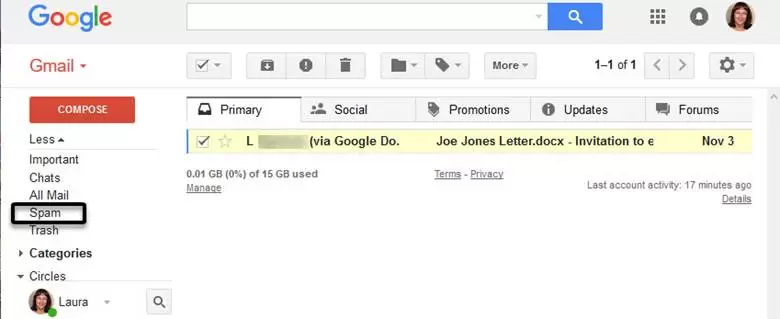How to Block Someone on Gmail?
You are probably one of those people who receive dozens and maybe hundreds of emails every day, But not all of these emails are useful or even intended for you. Fortunately, Gmail has a very good spam management system; However, you may still receive messages you do not like.
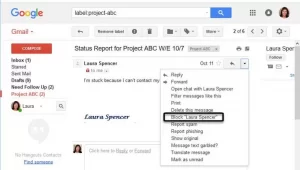
Sometimes it happens that even though you have requested to be removed from a project, you still receive emails related to it, or someone may send you unpleasant and annoying messages, or you have previously subscribed to an email newsletter. And now you no longer want to receive its emails. Maybe these unwanted spam messages are from a stranger.
It doesn’t matter who sends you these emails; In any case, if you receive spam emails and use Gmail, there are steps you can take to manage or even block them. In this tutorial, we explain how to block and filter unwanted emails.
Usually, spam emails are still sent to you after leaving a job or project; For example, you may have been working somewhere before, and now you still receive emails from there. Often your email address will remain on mailing lists related to that job or project.
Sometimes emails are sent by people you don’t know. These people are spammers and can get your email address in different ways. We mention only a few of them here:
- Guessing: They might use an algorithm to generate different types of emails. Then they send the same spam message to every generated email address.
- Hacking: Sometimes, security lists are hacked, and their details, including email addresses, are leaked.
- Buy: Some companies sell lists of email addresses. Often these lists are created when you respond to a free offer.
- Scraping: Spammers may use a tool to search the web for email addresses posted on the web. Then they send spam emails to the addresses they found.
Fortunately, Gmail is equipped with quite strong spam filters, apart from these tools, you can further reduce the possibility of receiving unwanted messages by using the following methods.
What to do with Internet harassment?
When it comes to spam emails, Internet harassment cannot be ignored. If you receive a threatening email, take the following three steps:
1- Save evidence: If you receive a threatening email, do not delete it. You should save this email as evidence of what is happening. Create a folder or label and save the message there.
2- Report email: Internet harassment should be reported to your online service provider. You can report the email via the link if the email sender uses Gmail. Also, if you are threatened by these emails, you should pursue the matter through the law.
3- Block the sender: If the sender of these emails is in your contact list, delete him. Block his future emails as well.
1- How to filter and block emails from a specific sender
Learning how to filter emails in Gmail or block certain emails is easy. You have the option to block emails from a specific user. You can stop receiving emails from this user or send his emails directly to another folder.
In the following, we explain how to block people’s emails:
The first method: How to block emails from a person
Start the blocking process by opening the email that the person sent you. In this case, we no longer want to receive any emails from this person, So we have to block him.
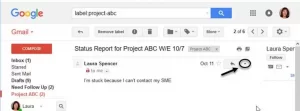
Click the down arrow to display a drop-down menu.
Now click the down arrow on the left and top of the screen to show you its drop-down menu.

Click the Block option to block that person’s email address in Gmail.
Select the Block option of the sender’s name. This will display a message asking you to confirm that future emails from this person will be marked as spam. In this way, these emails will be sent to your spam folder. Click the Block button in the confirmation message.
Open the drop-down menu again to unblock the sender.
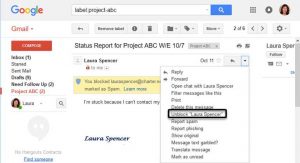
This time, select the Unblock option from the drop-down menu for the person’s name. This will show you a confirmation message stating that once the block is removed, future emails from this person will appear in your inbox. Click on the unblock option in the confirmation message.
Second method: Block a person’s emails automatically
Now let’s see how to filter and block emails of a specific person in Gmail. With this method, you can automatically block a specific person or send their messages to a specific folder. For example, you may want to filter all messages from a former employee to a specific folder. Here’s how to do it:
Start by opening Gmail.

The advanced search box will be displayed.
Click the arrow to the right of the Gmail search bar to display the advanced search box.
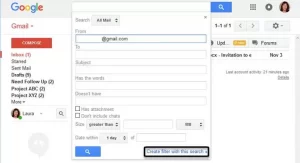
Now click on Create filter with this search link option.
Type the name of the sender whose messages you want to filter in the From field. You can apply more specifications to your filter by specifying more information in other fields. After entering the information, click on Create filter with this search link. In this way, the create filter box will appear.
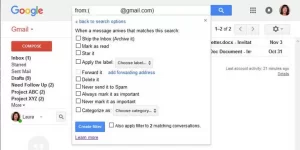
This box asks what you want to do with emails that match the criteria you defined in Gmail’s advanced search box.
Note that options like Delete it and Skip the Inbox keep these emails out of your Gmail. The Delete it option removes unwanted emails from your inbox and spam folder.
For example, I will send specified emails to a label called ex-employees that I created earlier.
Check the box next to Apply the label option. Click the arrows in the Choose label box. A drop-down menu shows the available tags.

Choose a sticker. Click the Create filter button to create a filter that will keep unwanted emails from your inbox.
Now click on the tag you want to send emails from a specific sender; in our example, it is Former Employees. This way, a message will be displayed at the top of your inbox saying that your filter has been created.
All messages from specified senders are now tagged and easily viewable. Use the Move To icon (which looks like a folder) to remove this message from your Primary tab, so you don’t need to see them anymore.
2- How to block a group of unwanted emails
As a small business owner, your email address may be on lists you do not want to receive emails from. Fortunately, most countries have anti-spam laws requiring the sender to provide recipients with a way to avoid receiving future emails.
Step 1- How to find subscriptions using the search
Finding the emails you have subscribed to is difficult because they are probably spread across multiple folders or labels. But there is no need to worry. You can use Gmail’s search feature to find all emails with an unsubscribe link.
Open your inbox and type “unsubscribe” in the search box at the top of the page.

Type “unsubscribe” in the search box to find all your subscribed emails.
To run a search, click on the icon next to the search box (in the shape of a magnifying glass). This way, a list of all emails containing the unsubscribe link will appear for you.

Click the search icon to find shared emails.
Now you are ready to unsubscribe from emails.
Step 2- How to unsubscribe from an email
In Gmail, there are several ways to unsubscribe from newsletters and other mailing lists:
1- Use the unsubscribe link: Go to the bottom of the email and click on the Unsubscribe link. (You can do this in other email services as well). The downside of this method is that you have to scroll to the bottom of the page to unsubscribe from emails.
2- Use Gmail’s unsubscribe feature: Gmail will find your email with an unsubscribe link. This link is displayed at the top of the email next to the sender’s name.
Now let’s examine each of these methods together.
Method 1- Use the unsubscribe link
In most emails, the unsubscribe link is at the bottom of the email. In our example, the unsubscribe link is at the bottom of the email newsletter we received from Envato.
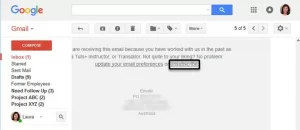
To unsubscribe from the email, click on the unsubscribe link.
After finding the unsubscribe link, click on it and follow the instructions.
Method 2- Use Gmail’s unsubscribe feature
Gmail can recognize the unsubscribe option at the bottom of the email. When this happens, an unsubscribe link will be displayed at the top of the email next to the sender’s email address. Here we show you how to display Gmail’s unsubscribe feature in the email we reviewed above.
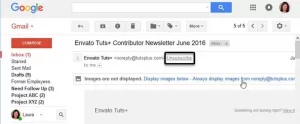
To unsubscribe from an email, click on the link and follow the instructions that ask you to confirm your decision.
3- How to report spam emails
Gmail uses a complex algorithm to send emails directly to the spam folder. Here are some examples of the types of emails that go directly to your spam folder:
Emails without content
Emails with misleading email addresses appear to be from a well-known company, But they are not.
Emails that appear to be phishing for your personal or financial information.
On its support page, Google has provided you with a complete list of email types they consider spam.
Next, we explain how to block spam emails:
Step 1- How to flag an email as spam
You can flag unwanted emails as spam. Doing this helps Gmail “learn” what kind of email you consider spam. Here’s how to flag an email as spam:
Start by opening your Gmail inbox. Do not open suspicious spam emails. Instead, click the confirmation box next to the email. Then click the spam report icon at the top of the emails.

Click the Report Spam icon to report an email and send it to your spam folder.
In this way, the email will be transferred to your spam folder. This function also provides feedback to Gmail for overall spam email filtering.
Step 2- Retrieve your email from the spam folder.
If you want to recover an email that was mistakenly or accidentally sent to the spam folder, follow the steps below:
Open Gmail. Click on the Spam folder in the list of folders on the left.
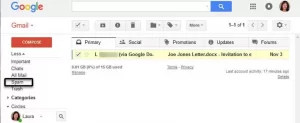
To select an email, click the check box next to it.
Find the email you want to recover by opening the spam folder. Click on the confirmation box next to the message and click the Not spam option above the emails.
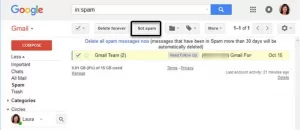
Click on the Not spam option to retrieve the selected email from the spam folder.
This way, a message will be displayed with confirmation that the message is not marked as spam and transferred to the inbox.
4- How to report fraud and phishing messages
There is a special category of spam emails that are destructive and troublesome. These emails are fraudulent and phishing messages. Scam emails usually contain a false offer. Phishing emails go one step further and seek to collect your financial and personal information.
An example of a scam email is an email claiming to be a product seller. If you purchased a product through a link in an email but never received the product (or received something other than what was promised), the email may be a scam email.
Phishing emails usually come from reputable sources, such as government agencies or financial institutions. For example, an email that claims to be from your bank and asks you to click on a link and enter your account number is considered a phishing email.
In most countries, email fraud is illegal and is considered a violation of the laws of most Internet service providers and against Google’s policies. If you receive such emails, you can follow them through legal authorities.
Conclusion
As someone who works in a certain profession, you no longer have to worry about spam emails. You can reduce the number of unsolicited messages received by email filtering and blocking functions in Gmail. If you know how to do this, you can prevent receiving fraudulent and possible phishing emails.
